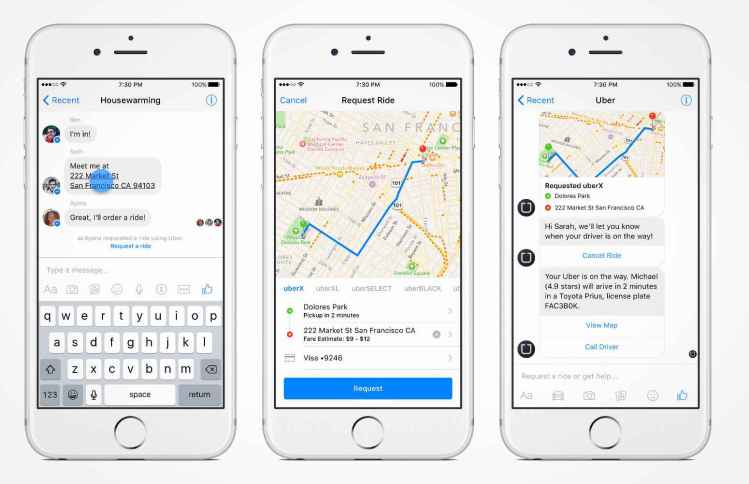Imagine this typical mobile conversation: A couple of friends quickly connect via chat to see if they can still make a concert that night. To find out if tickets are available, they leave their messaging app, open up their mobile browser or favorite ticketing app, and pay for the tickets; then return to their chat session to report on success.
How 2015.
That entire experience now — including purchasing the ticket — can take place right inside of their chat, unfolding in record time without any annoying steps in between.
Certainly, mobile commerce has been gaining ground quickly on traditional ecommerce. But now messaging and chat are looking to accelerate that trajectory even more. It’s all about ease, integration, and speed. Brands that enable consumers to make purchases inside messaging apps — such as Facebook Messenger — are making mobile purchases easier and faster than ever.
U.S. lags, eyes evolution in Asia
While the potential for in-chat ecommerce is just beginning in North America, it’ll be important to monitor such markets as Asia-Pacific for how in-chat ecommerce evolves. Mobile commerce is already high in that region — a recent Braintree infographic indicated that 46 percent of consumers in the territory used their smartphone to make a purchase in 2015 — and the high cost of SMS has quickly caused users to turn to free messaging apps. The Asian messaging app WeChat, with 650 million active monthly users, has played a significant role in accelerating the region’s in-chat ecommerce, with users who have long been accustomed to peer-to-peer and business-to-consumer payments for everything — from restaurant meals to transportation to utility bills with WeChat Wallet.
By contrast, unlimited SMS plans in North America limited the rise of messaging apps in the U.S…at least until Facebook made the strategic decision to move all messaging functionality from Facebook to Facebook Messenger in 2014. At the same time, other new messaging apps were rapidly appearing, and, over the last two years, the emergence of new messaging apps has doubled.
Yet, despite a smartphone penetration rate in the U.S. of 72 percent, the percentage of mobile users in the U.S. who made a purchase on a smartphone was only 27 percent. Obviously, though, there is significant growth potential for in-chat ecommerce in North America.
The U.S. opportunity — spelled out
No question, consumers now expect to shop and pay in the most convenient way possible, as quickly as possible. (Waiting is what you do in line at a brick-and-mortar store.)
And Facebook’s news in April announcing chatbots for Facebook Messenger sent a wake-up call to the industry. If you’re new to the lexicon, simply put, a chatbot is an A.I. (artificial intelligence) feature of a chat or messaging platform that simulates a human conversation with the user in order to provide them with the information or service they’re looking for.
Facebook’s entry signals massive opportunities given the combined 1.6 billion users on Facebook Messenger and WhatsApp — the messaging platform Facebook acquired in 2014. According to eMarketer, Facebook and WhatsApp are regarded as the two “global powerhouse apps” with significant reach in more than 20 countries worldwide. And the number of messaging app users globally is expected to reach 2.19 billion by 2019 — or 80 percent of smartphone users.
Leading North American in-chat players
In the few months since Facebook made its chatbot announcement, many U.S. companies have demonstrated an eagerness to jump on the chatbot wagon. Uber has been ahead of the curve for some time, allowing users to order an Uber car via Facebook Messenger. Ticketmaster will be rolling out the ability to purchase tickets through Facebook Messenger, and such brand giants as American Express, Expedia, Bank of America, and Staples are all developing chatbots using Facebook Messenger as their foundation.
Last February, PayPal launched PayPal Commerce, a platform for contextual commerce designed to provide a seamless and secure way for merchants to engage with customers — wherever and whenever their products are seen. Now, PayPal is partnering with Facebook Messenger to power Uber’s transportation services and is soon expanding into other areas, including ticket sales with Ticketmaster and Eventbrite.
But Facebook has company — and competition: Google, Kik, Line, Skype, Slack, Telegram, and Viber all have users who are fiercely brand- and service-loyal, giving these companies the potential to evolve into in-chat ecommerce app giants as well. Taco Bell has now introduced the Taco Bot, which is currently in beta test, in partnership with Slack. Kik recently announced an API so “anyone can build a bot” that can be added to its chat platform, and at the same time stated that 15 bots had already launched from such media and retail partners as H&M, Sephora, The Weather Channel, and Vine.
Although in-chat ecommerce adoption is still in its early stages in North America, the pace is increasing as messaging-platform providers and brands scramble to make it work for end users. The bottom line is: If you’re a mobile commerce company, the time to start planning your in-chat go-to-market strategy may be today.
Sponsored posts are content produced by a company that is either paying for the post or has a business relationship with VentureBeat, and they’re always clearly marked. Content produced by our editorial team is never influenced by advertisers or sponsors in any way. For more information, contact sales@venturebeat.com.

